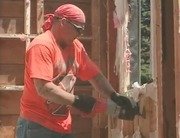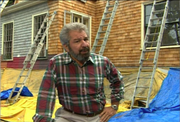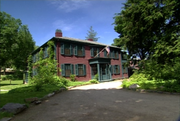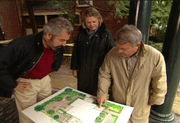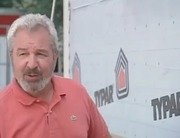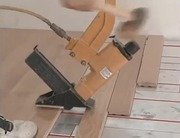We're visiting here at the Georgia Pacific Softwood Lumber Mill, and Randy Benoni will be our guide.
You know, we're looking at probably the biggest pile of timber you'd call it, because it hasn't been turned into lumber yet, that I've ever seen.
How, how many cords of wood are there?
Well, Bob, you're looking at roughly two thousand cords of southern yellow pine timber.
And when I think of a cord, I think of it in terms of firewood and its dimensional measurement - four by four by eight feet.
This is different, right?
Right, because we don't have the ability to measure it that way, we buy it by weight.
Roughly, fifty-six hundred pounds per cord.
And what you're looking at, like we said, was two-thousand cords.
Enough to keep the mill operating for about a week.
For about a week?
Yes, sir.
Now, is this grown like on tree farms?
Yes, sir.
It's what we call plantation timber.
There's very little virgin timber left in this part of this country.
So it's a renewable commodity.
Yes, sir.
It's planted and re-harvested every twenty-five to thirty years.
So it takes twenty five, thirty years to grow these lengths, which are maybe forty feet?
Yes, sir.
Forty feet or longer.
And probably anywhere from eight to ten inches in diameter.
Fabulous.
Now what's the first step in turning it into dimensional lumber?
Taking it from the log deck here to the sawmill, where we go through the debarker.
The debarker?
Correct.
Before the debarker, Bob, the logs have to be cut to length.
This is a decision that's made by a human operator -
Yeah.
- to try to minimize the amount of waste here.
So you've got maybe forty foot logs and you're trying to get sixteen foot lengths or twelve foot lengths and the like.
Exactly, to maximize the use of that forty foot log.
That saw blade looks to be...what's the diameter of that blade?
That's a 72 inch in diameter blade, Bob.
Amazing.
Now, Randy, explain to us how the debarker works.
Okay.
Bob, there's three steel cambios that are cylinder in shape, that literally eel the bark off the log.
There's 5 carbide blades that grab the log and rotate it.
As the cameos rotate and peel the bark off.
What do you do with all the bark?
Now it goes on to the pulp mills for fuel.
Is any of it used in landscaping?
Yeah , some plants send their bark on to be used as mulch.
Yes it is.
Okay, then what's the next step?
After coming from the debarker, being sorted and going through the metal detector, then it's on to the actual sawmill.
Why does it have to go through a metal detector?
Well, in this area there's a lot of hunting, Bob.
Hunters put up deer stands, may put nails in a tree, or even bullets, or shotgun pellets.
Right.
Yeah, yeah.
That of course would ruin your blade.
Exactly.
Now what is the lady doing in the control booth up here?
She is actually sorting the logs, by size and length.
Okay.
So this is the first place where they cut logs right?
Where you've got blades going?
Exactly.
This is where the logs enter the mill.
I can't hear you.
Let's go up in there.
Okay.
It's just too noisy to talk out there.
Now this is first place where the log actually encounters a blade, but what do you call these red turning things there?
Okay, those are the feeders, Bob.
The log is coming through the optimizer where the computer is determining what's going to get cut out of the log.
The feeder is then sending it into the chip and saw.
So this whole assembly here is called a chip and saw?
Correct.
Because its chipping away at the sides of the log and then its also sawing it.
Right, it's going to saw two sideboards off of the log and its gonna leave you with what we call a cant.
A cant?
Which is essentially a squared off log.
A slab of lumber.
Exactly.
And where does it go next?
From there it goes through the gang saws.
Who determines what you're going to get out of this cant?
The computer does.
It's all determined by the computer.
It makes several calculations, so that it can maximize what comes out of every individual log.
Based on yield and on possibly market conditions.
How do market conditions effect what you're deciding to cut here now?
Well the computer helps us to determine what to cut.
Market conditions tell us what the consumer is needing at this time.
So therefore, we program in what market conditions are.
Yeah.
The computer will take that into consideration and help us produce what will bring in the optimum amount of money for this particular sawmill.
Okay, so the computer's actually controlling this gang-saw.
Exactly.
How does the gang-saw work, how many blades do you have in there?
What happens is you have your four inch, or six inch or eight inch cant that are fed into the gang-saw.
It's a series of circular blades.
Yeah.
That then take that cant and slice it into two by fours, if it's a four inch cant, two by sixes, six inch, so on and so forth.
And here you go, you're getting Stud lumber coming out the other end.
Exactly you have a slab goes in one side and a 2X4 comes out the other.
Now, what's happening here?
Is it a sorting operation that goes on once it comes out of the gang saw?
It goes across the change where it goes into the sorter to be sorted by dimension and length.
And from there it goes on to the dry kilns.
Okay.
So once it's all been rough cut you stack it and space it like this so that you can dry it, right ?
Right, it comes from the sorter, Bob.
And this is what we refer to as our rough green lumber and it's ready for drying.
It's goes into the dry kilns where it stays at an even temperature of 350 degrees for about 18 hours.
Wow.
When it comes out we refer to it as our rough dry inventory, and then it's stacked and set aside for about two weeks before going on the the planer mill.
That of course is, the secret of good construction lumber is to keep it nice and dry.
What's the percentage when it leaves the operation here?
We dry it down to nineteen percent or less.
Your moisture content can be your single largest problem in lumber.
Yeah.
Now, I've also heard that you've got a terrific safety record here at this plant.
Exactly.
This plant is better than five times the national average.
They received the VIPs award last year.
And, this is all recognizable in the fact that you have to wear the colored vest...
Yeah.
The goggles, the hard hat, and the special shoes.
Let's go and take a look at that planer operation.
OK.
Alright Randy, once it comes out of the kiln, what happens next?
After if comes out of the kiln, it's what we call rough dry lumber, Bob.
It goes from the kiln to the planer, where it goes across the chains as it's being sprayed by a light mist of water to control the dust.
OK.
From there it's fed into the actual planer and surfaced on four sides.
Thus the term S4S lumber.
S4S.
There's four knives working at it at once?
Actually there's four heads, with knives on each individual head, surfacing the lumber on all four sides at one time.
OK.
And then what's happening over here at this station where these two fellows are working?
OK, the lumber is now Coming out of the planer, and going across what we call the grading table.
Where each grader is given just a few seconds to look at each individual piece.
Now, you have two graders there, so they're looking at every other board.
So these men are really the quality control of the operation.
Exactly, they can make or break a saw mill.
And what are the different grades that they're dealing with?
These particular graders are dealing with five different grades today.
Dense select structural being the highest grade or truss lumber.
Number one common and number two common being your framing lumber or lumber that goes on your treaters.
And number three common and utility is what we call industrial, that goes on to pallet manufacturers and crate manufacturers, and so forth.
Okay.
And then all of this sorting is done automatically.
Yeah, after it leaves the grading table.
Yeah.
The scanner reads the grader's mark, and it puts the appropriate stamp on each individual board, and then goes across the timing chains which dropped in the individual bins by dimension and by grade.
From there it's... Drops and goes to the bander, and it's banding the actual finished packages.
And ready...
And on to market.
And ready to go on to market.
Right.
Randy, it's a pretty impressive operation.
Very streamlined and clean.
Now, how much output do you have, in board feet let's say?
Bob, this particular mill about 1.6 million board feet a week.
As a company with 27 mills, about 45 million board feet a week.
A week?
Yes sir.
Or roughly enough to build the city of Charleston every week.
Every week?
Every week.
That's pretty astonishing.
Thanks for the tour.
Yes sir, anytime.
Stick around, we'll be right back after these messages.

